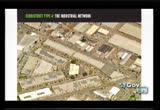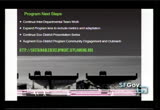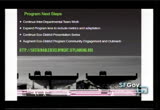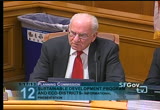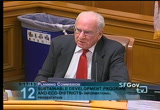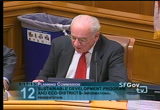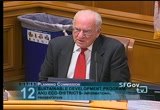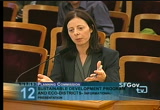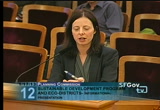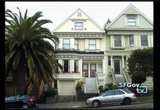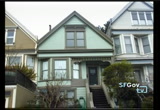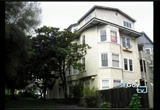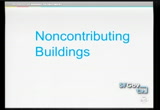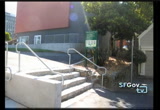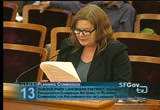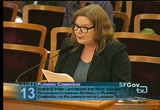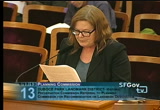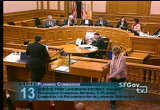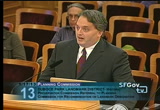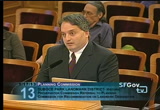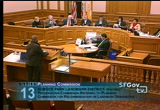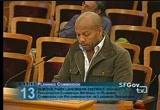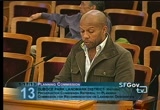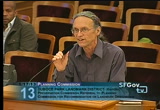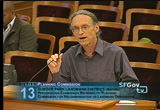tv [untitled] January 18, 2013 11:00pm-11:30pm PST
11:00 pm
then there's the distribution side. there is a way to make the distribution of these goods, through the city, cleaner. is that an electric vehicle fleet for gamp that will help with air quality in the area. so the -- just to conclude, we have some next steps here. we will continue our interdepartmental work. you can see that there's a lot that we are building on, and joining together as being a great experience for all of us. we'd like to expand our sustainable development program lands to include metrics and adaptation. we have -- we host ahh monthly ecodistrict presentation series which is really to keep our teams sharp. there's so much of this work is new. and innovative and we want to be
11:01 pm
able to ensure that we are -- our team is on that edge, as well as it's a public presentation series so the public is invited to bring the public into that as well. and to date, much of our work has been with the city family. and right now, we're about to embark and engage the community. so we've got a couple of outreach efforts. one is our type three ecodistrict through the living neighborhoods, and our central corridor, we're going to start a central corridor task force shortly to help inform the sustainability component to the central corridor plan. there's lots of information on the sustainable development web page. we did a summer internship program with swa group. there's an informational video on ecodistrict and a ecodistrict framework and the types and sustainable program in general. that concludes my presentation. thank you for listening and i'm available for questions you
11:02 pm
should have now or at any time. >> president fong: thank you. is there any public comment on this item? seeing no public comment, public comment's closed. commissioner antonini. >> commissioner antonini: thank you for your report. i got a few questions on some things that, you know, you may have not looked at or maybe you have. the central steam plant idea, it's very popular in manhattan and we have some of it here. i think i went by one near mid-plaza and it services a small area. but what they do is they have central steamers and they supply heat and presumably maybe air conditioning, but certainly heat, through the steam system for huge parts of manhattan out of a central plant. seems to me that's a good way of doing it. >> they serve about 120 buildings, i believe downtown.
11:03 pm
it's -- it provides heating and cooling. and it's a nice system because it takes boilers and chillers out of buildings, and buildings connect to a centralized system. and this helps in the efficiency, environmentally, and therefore also economically because it's a tighter system so it needs less power. but it also frees up space within the buildings that the building owners then could rent or do other things with. and one reason why i really like it is boilers and chillers in individual buildings aren't monitored through our bay area quality management districts requirements. because they're new small. so putting them into a centralized system requires that air quality that's associated with those companies that run those systems to be monitored. so ultimately it can result in cleaner air for all of us.
11:04 pm
>> commissioner antonini: that sounds great and hopefully we can persuade some of the existing buildings in parts of doubt to get involved with the -- downtown to get involved with a system like that and certainly new construction we've proposed a lot of new commercial buildings that will be constructed in the transbay area and that may be a wonderful site to have something like that and it also makes for a more pleasant heat. steamed heat is quiet and general and not forced air. they've gotten better with the forced air but it's sort of an on and off system and you either get real cool or too hot. it's not as balanced as steam heat in my opinion. i have a couple other suggestions. i assume your green buildings are encouraging having enough stairways. some of the buildings built in the 60's, particularly french hospital, many of the buildings don't have stairways and you have to either take the elevator or walk two or three buildings
11:05 pm
away to take the stairway and they felt no need for stairways in those days because nobody was going to walk up and down them. the other thing i wanted to ask you a question about is historic design and new buildings, we see all these buildings with nothing but glazing. and the windows have improved to where they can monitor the amount of sunlight, heat, that comes in, and keep it from getting really hot and needing so much air conditioning on the inside, but it would seem to me a more traditional buildings designed particularly in lower buildings, where you have thicker walls, you have awnings or eves that cover shade part of the area outside to keep the sun from coming directly on#
11:06 pm
anymore. >> the existing building retrofits are the low hanging fruit in all this work because that's where you can -- that's where you should is start. >> commissioner antonini: yeah, that's for sure because they've already got the structure there and all they have to do is keep it there, and -- to try to get a new building built that way it's probably more costly to do it with that much less glazing and more walls, and so, you know, that may be one reason why we don't see it. i don't know. but that's my opinion anyway. maybe somebody knows more about it who's an architect and can comment. they claim the glass frameworks are expensive but it seems like they go up pretty fast and seems to me that's lot less expensive to build. >> our green building ordinance is pretty strict and does a good job -- oongeddle but they have to use artificial heating and cooling systems to keep the
11:07 pm
temperatures even whereas buildings that are thicker keep the temperature in because of the thickness of the walls and temperatures from outside can't make it too warm or too cold. and finally, the last thing i was going to ask about is whether you have any cooperation with mta on their planning of community roots, and how things are being done. because they seem to be very inefficient, as far as the -- we still see quite a few diesel buses around, although we've converted a lot of them to electric. it seems like some of the routes duplicate each other. is there a way that you can work with sustainable transit ideas? >> we're looking -- well there's a -- if we lookedalty the central corridor for example there's a significant public realm component to that plan, that looksm$( +q to transit rou,
11:08 pm
and encouraging walking. our work is more focused really with almost at this point with what happens below ground. we put in an application with the state for a grant that looks at innovative technologies like capturing the heat that would come from the central subway's brake pads and using that to help provide heat in the district. so that's where we engage with mta in this work in particular. >> commissioner antonini: it sounds like you're working more with what is already there and using it more efficiently and using the energy that's already generated. >> yeah, and connecting those infrastructure systems. you know, if the roads are going to be opened up for improvements, a new central subway, is that an opportunity for us to put infrastructure sustainable infrastructures in that are connected with the
11:09 pm
buildings, or the public realm improvements for the central corridor are significant. you know, there's some alleyways over to create more open space in the area. is there a way that we can help capture some of the water that's coming from the ground, to help irrigate that land. so really trying to look at the fiscal qualities of the area, look at what capital improvements are proposed for the area, look at growth that's planned for the area, and see if there's a place where all those efforts can connect to create a more environmentally and economically efficient system that benefits both the city as well as the private sector, the community. >> commissioner antonini: thank you. >> is you're welcome. >> president fong: okay. appears to be no other questions. thank you very much. >> thank you.
11:10 pm
>> commissioners, that will place you item 13, case no. 2011 .0683l duboce landmark district bounded by waller street, scott street and northern boundary of duboce pa park. >> good afternoon, commissioners, mary brown, department preservation staff. i have prepared a slide show to show images of buildings and character defining features in the district and this will play continuously throughout my presentation. the item before you is to provide recommendation to the board of supervisors on the proposed duboce park landmark district. pursuant to article 10 of the planning code the planning commission has requested to provide review and comment on three items specifically.
11:11 pm
first, to address the consistency of the proposed designation with the policies embodied in the general plan and priority policies of section 101.1. in particular, the provision of housing to meet the city's regional housing needs allocation and the provision of housing near transit corridors. second, to identify any amendments to the general plan necessary to facilitate adoption of the proposed designation. and third, to evaluate whether the district would conflict with the sustainable community strategy for the bay area. the proposed district is bounded by waller street, steiner street and the northern and eastern boundary of duboce park. the boundary jogs slightly south of the park's entrance at karm lita, pierce, to accommodate the historic steps and rock retaining walls. the district is residential, comprised of 79 contributing buildings, eight
11:12 pm
non-contributing buildings, and three contributing interior block park entrances. properties in the district are zoned rh-2 and r2o. the district is significant for the unusual development history of the contested track of land upon which it is built and the way in which the contested nature of the tract impacted the district's physical appearance in the adjacent park. the the district is built on one half of what was historically a tractd of land known as the public reservation, hospital lot and marian track. the other half is publicly owned and is the site of duboce park. the the site is significant for high level architectural -- it is remarkable intact grouping of victorin and edwardian. the queen ann style is represented as well as effusion,
11:13 pm
edwardian and victorin detailing. architect who elaborately applied millwork. the designation process began june 2011 when hpc added the proposed district to the landmark designation work program. as part of this process the department engaged in robust community outreach funded by a federal preserve america grant. the department hosted eight community events focused on the proposed districts and on tailored levels of review for future alterations to build in the district. outreach events included a neighborhood history walking tour, two ask a planner nights and five community meetings and workshops. in addition the department provided updates at the duboce triangle neighborhood meetings and in the association's newsletters. details on specific outreach are
11:14 pm
included in your report. as a result of the community meetings and community feedback the department developed a highly tailored review process within the proposed district. the identified review as outlined in the designation ordinance in your packet is specific to this neighborhood. it identifies scopes of work that qualify for particular levels of review, ranging from a certificate of proposesness, an administrative of appropriateness. work qualify for no additional review or administrative staff level review if conditions are met. at the urging of the community supervisor scott wiener led an effort to amend the mills act program to increase access to financial incentives. these amendments which go into effect in october make the process quicker, cheaper, and more predictable. also the request of property
11:15 pm
owners and supervisor scott wiener the department created an on-line questionnaire to so solt feedback. the questionnaire was available if three weeks in november and produced a total of 38 valid household responses. the vast majority of responses were provided by property owners. property owners submitted the proposed designation by more than 2-1 ratio. 65% of property owners support the designation and 29% opposed. recent amendments has support. over 30% of property owners within the district participated and break down of responses is provided in your case report. on december 5, 2012 the historic preservation commission initiatived designation and on december 19, that commission voted to recommend designation
11:16 pm
to the board of supervisors. the department has determined that the proposed landmark district designation appears to be consistent with the general plan and will not necessitate general plan amendments. urban design elements of objective two policy are relevant as they call for preservation of notable landmarks and areas of historic and architectural value. the proposed designation appears to be consistent with the eight priority policies of section 101.1 as documented in the case report. the designation would preserve historic buildings, encourage protection of existing housing and neighborhood character and would provide new financial incentive for preservation by qualifying property owners to qualify for the mills act program. designation appears to be consistent with range of policy and objectives included in the market and octavia program. it will promote preservation of
11:17 pm
historic buildings abilityd review future alterations for compatibility to the secretary of interior standards. in addition to preservation of buildings proposed designation maintains connection between residential buildings in the park through park entrances which provide a tangible connection to the district's historical development. the proposed designation does not conflict with regional housing or environmental politics as broadly outlined in the sustainable strategy for the since publication of the agenda in packets the department has received public comments in opposition and in support of the proposed district. the department was cc'd on letters opposing the designation. in addition the the department received e-mailings of support from three property owners in which the commissioners were not cc'd. these property owners were lynn baker, dan proffero and peter
11:18 pm
strauss. the department is aware of a flier containing information inconsistent with information presented at public events and hearings and the department is available to answer or address any questions you may have about this. finally, based on staff analysis, the resolutions adopted by the hpc and the community input, the department recommends that the planning commission recommend designation as proposed -- to the board of supervisors. the draft resolution is included in your case report. following your review and comment, the department will forward the designation to the board of supervisors, with resolutions from both commissions. that concludes my presentation. and myself and my colleague, tim frye, preservation coordinator are available for questions. >> president fong: thank you. public comment on this item, i have a few speaker cards, jonathan goldberg, jason
11:19 pm
lonberg, john scham. bray, and david fix. >> good afternoon. my name is jason, i live at 56 pat tomorrowic street. i've lived there just about 10 years with my family. i absolutely love this neighborhood, the people, the buildings, the parks. it is truly a magical neighborhood in our city. i also applaud the notion of celebrating the history of our neighborhood. i think there's a lot to celebrate there. the process that supervisor wiener and mary brown have followed has been have been good however i'm completely opposed to this particular proposal. i believe that it is redundant in many ways, it's burdensome to the people who live and own in the neighborhood. and it provides nothing for our
11:20 pm
neighborhood, and in particular the park, which even as mary mentioned is central to the history of the neighborhood. i've actually e-mailed all of you my specific articles so you have that detailed. what i want to put on the record today is a list of 18 residences, 16 are owners, all of them are opposed to this designation. this is not lent to represent everyone who is opposed but those who i could speak with personally and gave me permission to present their names today. so i have -- i was at the mercy of someone else's printer so i only have one copy but i will provide that. and so despite what i believe are the best intentions by the city to run a survey, i know that myself, i did not receive a card in the mail. i know several other neighbors were not notified. and so that is why i went around and actually started to talking
11:21 pm
to people because i didn't feel it accurately represented what was going on in our neighborhood. if you look at these numbers what you have is really a neighborhood that is split. and i think that's unfortunate. i think we're still a very cohesive neighborhood but we are deeply divided on this issue and i would like to put a stop to this particular proposal. thank you for your time. >> president fong: thank you. >> plug this in. provided this computer monitor. you can put a flash card in. they had trouble with other people's computers. >> fair enough. good afternoon. jonathan goldberg i live at 60 potomac street i am here to speak in opposition to dh as well. i want to talk about a few things, in particular i want to
11:22 pm
address the case made by staff and some of the numbers that mary spoke to you about that i believe are included in your packet. to begin with, neighborhood sentiment, there was an on-line survey she mentioned which she said 2-1 favored this proposal. in actuality over 50% of the people in the neighborhood did not actually respond to the survey. they got 39 responses out of 88 people that they polled so that's less than half. but then actually if you look into that more detail, she mentioned 87 or 88 residences. that's actually the lot numbers. if actuality there are 160 addresses in the zone covered and if you factor that in you have two-thirds of the people in the neighborhood not responding. i didn't receive any notification of this, so if you factor in people that are miss votes as well you have a pretty evenly split neighborhood, but a very large number of people in the community didn't respond,
11:23 pm
aren't aware of it. and i think that speaks a lot to the staff's outreach efforts. it really wasn't as strong as they like to spend all the time they spent on it. people don't understand what's going on in the neighborhood, what's going on with this. in particular there's a lot of inaccuracies. i noticed in the data, in the original proposal if you look on the website the original zone includes a map that covers the zone and includes the park. in more recent addition than probably what's in your packet the historic designation does not include the park. if we're going to have a duboce historic zone shouldn't it include the park. this speaks to the outreach effort that the hpc has no ability to live up to. we talked to them about 16 entrances to the park, maintaining the park better to meet historic standards and they really have no way to enforce that. so finally i also have a question around tax benefits.
11:24 pm
this has come up a lot in our neighborhood meetings. nobody understands the millsabilitmills actand to our s taken advantage of it supervisor wiener has improved the law but that sounds like a gini pig situation to me. i emphasize there are people in the community feel this will greatly add to the cost of living there in terms of extra designer fees, contractor, expediter fees and that will make it hard for people with young families to stay in the neighborhood. thank you. >> president fong: additional speakers who have called? >> hello. my name is kenneth wingard on the castro benefit district and the market octavia plan community advisory committee. and have a degree in architectural preservation.
11:25 pm
today i am here as a four decade resident of the neighborhood. i've renovated a 1860's cottage that was designated as unsalvageable and in 1905 edwardian that had fallen into disrepair. i fell in love with the neighborhood with these diamonds in the rough and have been delighted at the current glorious state of the neighborhood. there is no question that everyone loves the neighborhood. my lovely neighbors who i respect a lot, myself, it's just a matter of how we should take care of the neighborhood that we love. the charming idea that everyone can look out for the neighborhood themselves is unfortunately unrealive. one needs to look back at the 50's and 60's to see the travesties that can happen but in the recent past, the minor situations like the three unit building across the street from myself on potomac where the owners decided to renovate it,
11:26 pm
unfortunately through a bunch of inappropriate arguable details and slabs of green marshal on a victorin building that looks woefully torn divn three different decades, the cottage on germaneia that's been torn down and replaced about i a glass and steel house but the charm of the -- is lost forever. there are homes on 66 pa to himmic, the homeowners have worked to create a stunningly beautiful and appropriate facade that i believe now seamlessly unites potomac street. it is a rare set of circumstances that came together 110 years ago to lead to the creation of these buildings and another set of circumstances in the 50's and 65's and 70's that left them untouched. we have opportunity to stop the risk taking with this neighborhood. these homes were here before we
11:27 pm
were and with any luck they will be here long after we are gone. we are stewards and our jobs should not be to maximize return but care for them gently to be passed on to the next generation. i urge to go if order with the 65% of the responders and move this forward. >> president fong: thank you. peter strauss and any other speakers that i've called. >> good afternoon. peter strauss. i have a home at 79 pierce street. first of all, i really want to commend and thank mary brown and the staff for doing what i think is an excellent job in moving this to the state it is today, including the work on the mills act credit in particular, and trying to address some of the concerns of my neighbors. i've lived at 79 pierce for almost 30 years.
11:28 pm
right after i moved into thei n neighborhood, i immediately became aware of the architectural consistency of the victorines in our neighborhood. in fact this is a document we were talking about earlier. i quickly became aware of the 1987 preservation element of the master plan. one of the things included in that was a map of architecturally significant buildings in the city by the density per block and it turns out that this area around duboce park, including but not just limited to this proposed landmark district is really the largest concentration of architecturally significant victorines in the city. it's the largest clump of dark black area on this map. and the heart of that is what purports to the historic district today. i also note -- i'm also the owner of a condo at 573 waller, that a friend occupies, which is
11:29 pm
one of the non-contributing buildings, one of the most egregious examples of non-contributing buildings, and that leaves me both very aware of a building that deserves preservation, and very aware of what can go wrong when buildings are treated inappropriately. as i understand it, the -- one of the key issues facing the planning commission today is the consistency of the landmark's proposal to the general plan. it was the market octavia planning effort that initiated the product that's before you today. it's in addition to the specific policies, the minut market octaa planned looking at the appropriateness of the historic district. in additionk,jayo establishing n historic distrguc) &w here is on
76 Views
IN COLLECTIONS
SFGTV: San Francisco Government Television Television Archive
Television Archive  Television Archive News Search Service
Television Archive News Search Service 
Uploaded by TV Archive on

 Live Music Archive
Live Music Archive Librivox Free Audio
Librivox Free Audio Metropolitan Museum
Metropolitan Museum Cleveland Museum of Art
Cleveland Museum of Art Internet Arcade
Internet Arcade Console Living Room
Console Living Room Books to Borrow
Books to Borrow Open Library
Open Library TV News
TV News Understanding 9/11
Understanding 9/11